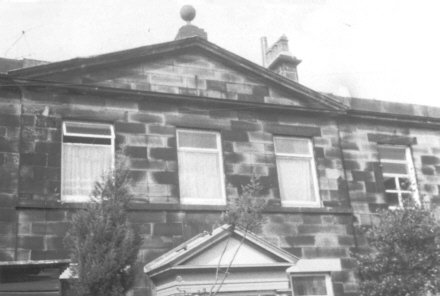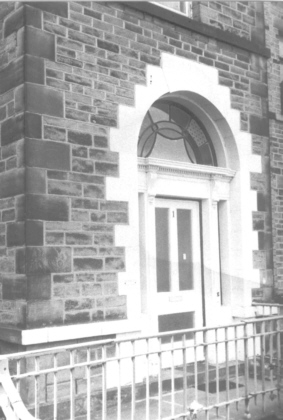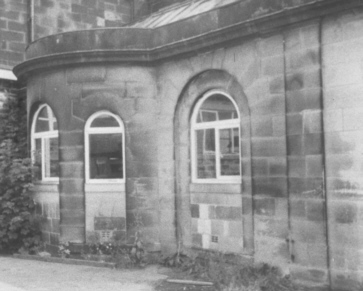Page revised 21 August
2001
EDWARD LAW
HUDDERSFIELD &
DISTRICT HISTORY
THORNTON
LODGE.
Edward J Law
Thornton Lodge, which in
the early ninteenth century held a place of some importance in
Huddersfield, has received little notice from local historians.
At the present time the area is very largely inhabited by an
immigrant population and is a relatively isolated area in that it
is not traversed by main roads.
This history commences three
centuries ago. In 1686 Nicholas Fenay of Wakefield, but of the
Fenay Hall family, married Jane Thornton. Included in the
marriage settlement were cottages, mills and land in Fenay,
Lockwood, Ewes, Longroyd Bridge and elsewhere. Nicholas and Jane
had several children, but all but one died young. The heir to the
above estates was their daughter Jane Fenay. A tradgedy befell
her in her twenties, she was to have married John Savile of
Methley but on 9 May 1713 after attending a cock-fight at the
White Bear Inn in Wakefield he fell into a well in the yard. A
rescuer was lowered in the bucket and both were being drawn up
when the rope broke and they were drowned. It is said that Jane
Fenay never got over the loss and certainly she never married.
She lived to the age of 75, dying
in Wakefield in 1766. She left an interesting will which included
£100 to the poor of the town of Almondbury. Almost the whole of
her real estate was left to her cousin, Richard Thornton, a
merchant in Hamburg, with the wish "that none of my ancient
estates be ever sold but remain in the possession of one of good
uncle Thornton's offspring." Uncle Thornton was Richard who
had been Recorder of Leeds and grandfather to the Hamburg
merchant.
Richard Thornton at least was true
to Jane Fenay's wish and in 1790 he bequeathed the estates to his
son John, whom he described as a member of the company of
merchant adventurers to England residing in Hamburg, and daughter
Johanna Catherine, the wife of Peter Godeffroy, also of Hamburg.
They, however, took an early decision to realise the inheritance
and a sale by auction was arranged at the George, Huddersfield on
23 and 24 November 1791.
At the sale the Longroyd Bridge
property which had been mentioned in the settlement of 1686 was
sold in two lots. The main portion, two messuages, 9 cottages, a
barn and 19½ acres of land was bought for £2,870 by Thomas
Tipping of Manchester, and a further block of land of nearly 11
acres went for £1,125 to John Horsfall of Huddersfield, merchant.
Ten years later Tipping sold his estate to John Horsfall for £2,950.
It appears to have been about this time that John Horsfall
decided to build a mansion for himself.
The Horsfalls had been clothiers at
the Well in Huddersfield for centuries, John and his brother Abraham had developed a merchanting business,
which continued to operate from the family homestead, and a mill
at Marsden. The Well stood alongside Beast Market, an area which
was being given over to cropping shops and warehouses, and losing
the status which it once had. The Horsfalls were clearly
prospering and John probably felt that it was time to move out of
the town to a modern residence in the country. The mason he chose
to erect his mansion was Joseph Kaye, a local man who was to
become Huddersfield's foremost builder.
Abraham had developed a merchanting business,
which continued to operate from the family homestead, and a mill
at Marsden. The Well stood alongside Beast Market, an area which
was being given over to cropping shops and warehouses, and losing
the status which it once had. The Horsfalls were clearly
prospering and John probably felt that it was time to move out of
the town to a modern residence in the country. The mason he chose
to erect his mansion was Joseph Kaye, a local man who was to
become Huddersfield's foremost builder.
Kaye was then a young man, at the
beginning of his career. He was born about 1799 and started work
at Manchester, walking there and back each week. We may assume
that Horsfall would have had to be satisfied as to Kaye's ability
to erect what was to be a substantial and far from
straightforward building, and one in which he was prepared to
invest a large amount of money. It would appear that his
confidence was well placed for the building still stands with
sound fabric, though much defaced by additions and partitioning.
Part is now known as Thornton Lodge Hall, but originally it was
just Thornton Lodge; the origins of that name clearly the
Thornton family who, as we have seen, held the estate at one time.
The name apparently came with the mansion, the first use I have
seen was in April 1804, and I believe the mansion would have been
built between then and February 1802 when John Horsfall purchased
the additional land from Tipping. The grounds of Thornton Lodge
were the area between Manchester Road and Yews Hill Road, its eastern boundary being
where Thornton Lodge Road is now built and the western boundary
would have been a line from the Griffin Inn bowling green to the
southern end of Moorbottom Road.
Yews Hill Road, its eastern boundary being
where Thornton Lodge Road is now built and the western boundary
would have been a line from the Griffin Inn bowling green to the
southern end of Moorbottom Road.
John was evidently satisfied with
his house and estate, one may imagine what a pleasant environment
it was in which to bring up a family. Both he and his wife died
at the house, his wife in 1820 and he in 1831. He had three sons,
all of whom predeceased him without issue, and two daughters.
Ellen was married to William John Norris, a Halifax man, and Ann
was a spinster, he left them £10,000 each, and Thornton Lodge
was left in trust for Ann.
Ann Horsfall does not appear to
have resided long at Thornton Lodge after the death of her father,
if at all. By 1834 James Brook was living there. In 1840 William
Leigh Brook, and in the mid 1840s John Starkey, whose mills were
at Longroyd Bridge. In 1847 the trustees of John Horsfall's will
sold the estate on behalf of Ann Horsfall, who was then living in
London, to Joseph Armitage of Milnsbridge House for £8,500. He
continued to let the property, and during the 1850s the tenant
was 'Squire' Brooke; the evangelical Edward Brooke whose
memorialist (Rev J H Lord, Memorials of Edward Brooke)
wrote:
Thornton Lodge was beautifully
situated on gently rising ground and nestled among trees,
which afforded pleasant and salubrious shelter. It was a
spot where health might be supposed to make its home, but
for some cause, at the time inexplicable, typhoid fever
made its appearance and lingered about the place, and
would not be driven away, prostrating Mrs Brooke and one
and another of the family.
In 1854 Brooke moved to the
Fieldhouse estate which he had bought, and where he developed
extensive brickworks, and Thornton Lodge was offered for sale. It
did not sell, but by 1857 a buyer was found, John Woodhead
Crosland, woollen cloth manufacturer, who purchased the estate
for £5,000,
The vast decrease in the value of
the estate is hard to understand. The main blight would
undoubtedly have been the railway line from Huddersfield to
Penistone which took a small corner of the estate. Howevere, the
line had been promoted in 1845, two years before Armitage
purchased and one would have thought the detrimental effects
would have been discounted in the price he paid. The incidence of
typhus may have affected the value and another important
consideration would have been the pollution from the mills
established in the valley bottom at Longroyd Bridge and those of
the Croslands a little higher up the old Manchester Road.
Some thirty years later, in 1886,
the estate was sold by J W Crosland's executor for £7,000 to
John Marsden, who died the following year. There is one sketch of
the property which shows it in something approaching its original
condition, made by Noel Spencer it was reproduced in the
Huddersfield  Examiner of 15 January 1957. The sketch
shows an ornate iron porch above the front entry on which were
the initials J.M. for John Marsden, also visible is the tower
which was mentioned in sale particulars of 1887. Following John
Marsden’s death title passed again, Joseph
Armytage Armitage of Storthes Hall and John Henry Hanson paying
£6,250 for the estate. The latter sale probably signalled the
eventual fate of the area for Hanson was a surveyor in Huddersf
ield and no doubt recognised the potential of this freehold
estate lying close to the town. It is significant that when
development did come it was mainly working class housing, there
were no middle class houses, no handsome villas, clearly the area
wore the mask of industry which automatically marked it out for
high density, relatively cheap housing. Dates on houses in
Moorbottom Road show that development was in hand by 1889. In
1899 Hanson became the sole owner, purchasing Armitage's interest
from his executors.
Examiner of 15 January 1957. The sketch
shows an ornate iron porch above the front entry on which were
the initials J.M. for John Marsden, also visible is the tower
which was mentioned in sale particulars of 1887. Following John
Marsden’s death title passed again, Joseph
Armytage Armitage of Storthes Hall and John Henry Hanson paying
£6,250 for the estate. The latter sale probably signalled the
eventual fate of the area for Hanson was a surveyor in Huddersf
ield and no doubt recognised the potential of this freehold
estate lying close to the town. It is significant that when
development did come it was mainly working class housing, there
were no middle class houses, no handsome villas, clearly the area
wore the mask of industry which automatically marked it out for
high density, relatively cheap housing. Dates on houses in
Moorbottom Road show that development was in hand by 1889. In
1899 Hanson became the sole owner, purchasing Armitage's interest
from his executors.
Plans of the estate show it to have
been a typical gentleman's residence. There were two lodges, both
on the Manchester road at either extremity of the estate. The
main entry was along a carriage drive off the main road by the
easterly lodge, an entry by the west lodge was no doubt the
service drive. Most of the grounds were laid out as parkland but
there was an area to the west of the house which was probably
laid out as amenity land, among which were a vinery and a pond,
both of which were apparently casualties of the railway line.
The old house is still there,
partitioned into private dwellings and partly extended to house
Thornton Lodge Bowling Club, its most distinguished feature the
rounded section on the northern front which would have been the
principal entrance. Its front has been much disfigured by an
extension, part of the club, but the rear of the house is quite
attractive and there are still interesting features though the
tower no longer exists.
Return to HOME.
 Abraham had developed a merchanting business,
which continued to operate from the family homestead, and a mill
at Marsden. The Well stood alongside Beast Market, an area which
was being given over to cropping shops and warehouses, and losing
the status which it once had. The Horsfalls were clearly
prospering and John probably felt that it was time to move out of
the town to a modern residence in the country. The mason he chose
to erect his mansion was Joseph Kaye, a local man who was to
become Huddersfield's foremost builder.
Abraham had developed a merchanting business,
which continued to operate from the family homestead, and a mill
at Marsden. The Well stood alongside Beast Market, an area which
was being given over to cropping shops and warehouses, and losing
the status which it once had. The Horsfalls were clearly
prospering and John probably felt that it was time to move out of
the town to a modern residence in the country. The mason he chose
to erect his mansion was Joseph Kaye, a local man who was to
become Huddersfield's foremost builder. Yews Hill Road, its eastern boundary being
where Thornton Lodge Road is now built and the western boundary
would have been a line from the Griffin Inn bowling green to the
southern end of Moorbottom Road.
Yews Hill Road, its eastern boundary being
where Thornton Lodge Road is now built and the western boundary
would have been a line from the Griffin Inn bowling green to the
southern end of Moorbottom Road. Examiner of 15 January 1957. The sketch
shows an ornate iron porch above the front entry on which were
the initials J.M. for John Marsden, also visible is the tower
which was mentioned in sale particulars of 1887. Following John
Marsden’s death title passed again, Joseph
Armytage Armitage of Storthes Hall and John Henry Hanson paying
£6,250 for the estate. The latter sale probably signalled the
eventual fate of the area for Hanson was a surveyor in Huddersf
ield and no doubt recognised the potential of this freehold
estate lying close to the town. It is significant that when
development did come it was mainly working class housing, there
were no middle class houses, no handsome villas, clearly the area
wore the mask of industry which automatically marked it out for
high density, relatively cheap housing. Dates on houses in
Moorbottom Road show that development was in hand by 1889. In
1899 Hanson became the sole owner, purchasing Armitage's interest
from his executors.
Examiner of 15 January 1957. The sketch
shows an ornate iron porch above the front entry on which were
the initials J.M. for John Marsden, also visible is the tower
which was mentioned in sale particulars of 1887. Following John
Marsden’s death title passed again, Joseph
Armytage Armitage of Storthes Hall and John Henry Hanson paying
£6,250 for the estate. The latter sale probably signalled the
eventual fate of the area for Hanson was a surveyor in Huddersf
ield and no doubt recognised the potential of this freehold
estate lying close to the town. It is significant that when
development did come it was mainly working class housing, there
were no middle class houses, no handsome villas, clearly the area
wore the mask of industry which automatically marked it out for
high density, relatively cheap housing. Dates on houses in
Moorbottom Road show that development was in hand by 1889. In
1899 Hanson became the sole owner, purchasing Armitage's interest
from his executors.